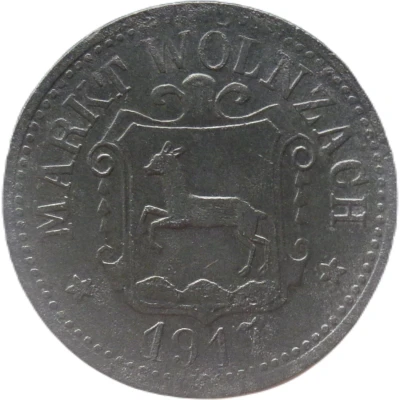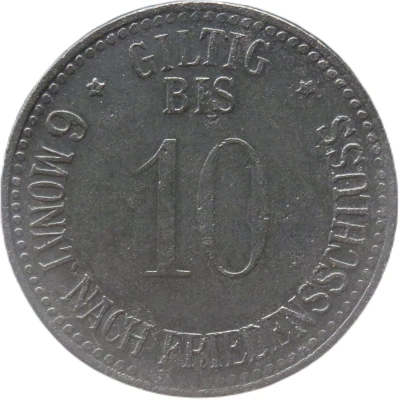


© Willem63 (CC BY-NC-SA)
10 Pfennigs - Wolnzach
1917 year| Zinc | 1.7 g | 20.0 mm |
| Issuer | Market Town of Wolnzach (Federal state of Bavaria) |
|---|---|
| Emperor | William II (Wilhelm II) (1888-1918) |
| Type | Standard circulation coin |
| Year | 1917 |
| Value | 10 Pfennigs (10 Pfennige) (0.10) |
| Currency | Mark (1914-1924) |
| Composition | Zinc |
| Weight | 1.7 g |
| Diameter | 20.0 mm |
| Thickness | 0.9 mm |
| Shape | Round |
| Technique | Milled |
| Orientation | Medal alignment ↑↑ |
| Demonetized | Yes |
| Updated | 2024-10-04 |
| Numista | N#78452 |
|---|---|
| Rarity index | 89% |
Reverse
Pearl rim, legend surrounding denomination.
Script: Latin
Lettering:
GILTIG
BIS
10
★ 6 MONAT NACH FRIEDENSSCHLUSS ★
Edge
Plain
Comment
Issuing organisation: [Markt, Bayern].Interesting fact
The 10 Pfennigs - Wolnzach 1917 coin was minted during a time of economic turmoil in Germany, known as the "Inflationary Period" (1914-1923). During this time, the value of the German mark (the national currency) plummeted, and prices for everyday goods skyrocketed. As a result, many Germans turned to alternative forms of currency, such as local coins like the 10 Pfennigs - Wolnzach 1917, which were issued by municipalities and local governments. Despite being made of zinc, a relatively inexpensive metal, these coins were highly valued by the people of Wolnzach and surrounding areas, as they were seen as a more stable store of value than the rapidly depreciating national currency.